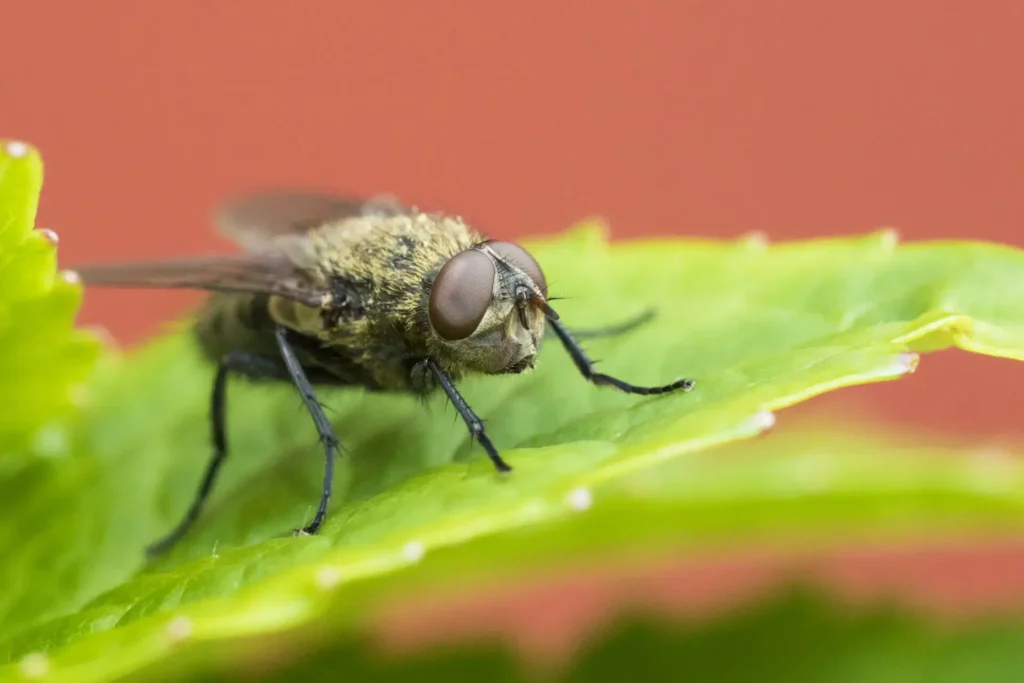You may have noticed groups of flies on your windows recently, especially if you live in a rural area. I suspect you don’t care which kind of flies they are, but that’s one of the interesting parts of our job; identifying exactly what they are and understanding how to evict them from your home. Given the recent fluctuations in temperatures, I would be thinking; ‘Cluster flies’.
At first glance, cluster flies look similar to house flies; about 8 mm long with a dark grey body and iridescent wings. You may notice that their wings overlap or that their backs are covered in golden hairs, but it’s more likely that you’ll be looking for the can of fly-spray you stored away last autumn. That spray will kill every cluster fly it touches. That’s the good news. The bad news is that this species comes in large clusters (as its name suggests). If you’ve seen a few, it’s likely that there will be many more of them still dozing in the loft, garage or wall crevices, ready to emerge tomorrow or next week and cause fresh havoc. Cluster flies don’t bite, sting or transmit illnesses to humans, but having your living spaces filled with hundreds of slow-flying insects is an unpleasant experience.

Cluster flies emerge from their hibernation in spring to lay their eggs in soil. Three days later, larvae hatch from the eggs and attach themselves to earthworms as parasites to grow into their adult forms. In autumn, the adult flies hibernate in any place they can find that is dry and sheltered from the cold – under loose tree bark or in deep piles of fallen leaves outside. Houses are even better, and they are small enough to slip into your house through tiny crevices under the eaves or in cracked fascia boarding.
Once inside, they settle down to hibernate in quiet spaces like garages and lofts. Of course, we turn up the heating when the weather gets cold and wake them early. That’s when you see them clustering at the window, attracted by the light and keen to get out there and resume their spring activities. You could just open the window and shoo them out but once cluster flies find that your house is accessible, warm and dry, they or their descendants will return to hibernate there next autumn.
That may sound unlikely, but the other disadvantage of cluster flies is that they mark their hibernation spot with a greasy yellowish smear containing a pheromone. This has such a strong reek that even humans can smell it – a sickly sweet stink. Their offspring use that smell to guide them in to the warm, dry place where their parents had sheltered last winter and suddenly your cluster fly infestation is back. You can remove that greasy smear with soapy water and clean the area with disinfectant, but the flies will still smell that pheromone.
The best way is to kill off the flies before they can leave that scent marker. To do that you have to be very thorough and very lucky to spray all the flies as they emerge and before they mark their favourite hibernation place. Don’t forget to vacuum up all the dead flies, or scavenger insects and rodents might come to feast on their bodies. Same routine again tomorrow as more emerge… and the next day…

We recommend using specialist cluster fly killers. These have a fluorescent light to attract the flies and an electronic zapper grid. You’ll have seen these on the walls of chippies and sandwich shops, but cluster flies need a bigger capacity version to cope with the number of flies they’ll be dealing with. These zappers are chemical-free and reusable. But if it proves absolutely necessary, we can follow up with pesticides.
As professional pest controllers, we have access to more effective chemicals than the general public are allowed to buy. We can use a pesticide fog in the loft to kill off the flies wherever they are hiding so that they won’t survive to breed next year’s generation. We could also spray contact pesticides on windows in the house where they might land. These are pesticides that work after they have dried, killing flies that land on that surface.
After the flies have been removed, it’s worth making sure that it’s as hard as possible for them to get back into the house or garage. Seal up all the little cracks and gaps around the eaves of the roof and repair loose plaster or render. It’s good practice to clean any food spillages immediately, to remove smells that might fetch a new group indoors.
One last word on the subject. Please be aware that we have to check first that you don’t have bats living alongside the flies. Bats are protected by law, so we will not be allowed to use any chemicals in their roosting place. It’s not much consolation, but if you do have bats living in your loft or outbuildings, you can enjoy the sight of them swooping around at dusk on warm evenings – eating the flies and insects that might bother you.

